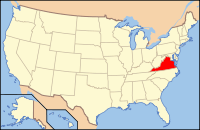Colonial Place
|
Colonial Place | |
 | |
| Location | Roughly bounded by the Lafayette R., Knitting Mill Creek, East Haven Creek and 38th St., Norfolk, Virginia |
|---|---|
| Coordinates | 36°53′05″N 76°17′20″W / 36.88472°N 76.28889°WCoordinates: 36°53′05″N 76°17′20″W / 36.88472°N 76.28889°W |
| Area | 202 acres (82 ha) |
| Built | 1903 |
| Architect | Dillard, George; et al. |
| Governing body | Private |
| NRHP Reference # | 02000532[1] |
| VLR # | 122-0825 |
| Significant dates | |
| Added to NRHP | May 22, 2002 |
| Designated VLR | June 13, 2001[2] |
Colonial Place is a residential neighborhood in Norfolk, Virginia. It is a peninsula bordered by 38th Street on the south, and surrounded on three sides by the Lafayette River. It is a relatively racially mixed area that includes mostly single family homes and a few apartment buildings. Many large homes front the water and Mayflower Road arches around the shore of the river.
The Colonial Place Historic District is a national historic district listed on the National Register of Historic Places in 2002.[1] It encompasses 1,090 contributing buildings and 4 contributing sites in a primarily residential section of Norfolk. It is a middle-class and upper middle-class residential neighborhood that largely developed during the period 1903-1941. The neighborhood includes notable examples of the Queen Anne and Colonial Revival styles. Notable buildings include the Richard W. Peatross House (1908), Taylor House (1908) and Stuart Elementary School.[3]
References
- ↑ 1.0 1.1 "National Register Information System". National Register of Historic Places. National Park Service. 2010-07-09.
- ↑ "Virginia Landmarks Register". Virginia Department of Historic Resources. Retrieved 19 March 2013.
- ↑ Laura V. Trieschmann and Jennifer J. Bunting (October 2000). "National Register of Historic Places Inventory/Nomination: Colonial Place Historic District". Virginia Department of Historic Resources. and Accompanying photo and Accompanying map
| |||||||||||

